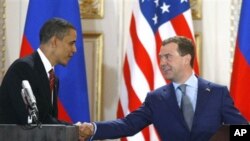The New Strategic Arms Reduction Treaty recently ratified by the U.S. Senate deals only with long-range nuclear weapons. Tactical nuclear weapons are often every bit as lethal as the strategic nuclear warheads, but they are designed to be delivered over shorter distances. They include land and air-launched missiles with a range of less than 500 kilometers - so called “battlefield weapons.”
Daryl Kimball, head of the Arms Control Association, a private research firm, said it is difficult to say precisely how many tactical warheads Washington and Moscow have because there is no formal treaty governing such weapons.
“Independent estimates suggest that the United States may have several hundred tactical nuclear warheads, including about 180 at five European NATO bases - in Italy, Turkey, Germany, the Netherlands and Belgium," said Kimball. "Russia is believed to have as many as 3,000 tactical nuclear bombs, but many of these are not in a condition to be used. Many are awaiting dismantlement or are in deep storage. And it is believed that the vast majority of those Russian tactical nuclear bombs are stored far away from their western border, from the European border.”
Many experts believe a majority of Russia’s tactical warheads are located on its eastern borders to compensate for what it perceives to be a nuclear threat from China.
Joseph Cirincione, president of the Ploughshares Fund, a foundation focusing on nuclear weapons policy, said there is another reason for Moscow’s vast superiority in tactical nuclear weapons.
“They [the Russians] have seen them, particularly since the end of the Cold War, as necessary to offset what they see as the conventional superiority of NATO and the United States," said Cirincione. "It is exactly the reverse of the situation we had during the Cold War where NATO fielded thousands of tactical nuclear weapons to offset what they thought were the superior Soviet tank armies.”
Cirincione says Moscow’s great number of tactical nuclear weapons is a throwback to the Cold War.
“It is still this kind of thinking that, one - there is actually an opponent here that poses a real military threat to you, even though Russia and NATO are no longer adversaries," said Cirincione. "And it is also this idea that somehow you can use nuclear weapons in a battlefield condition, that you would use these on your own territory to repulse an opponent’s attack. That is why you are seeing in most other countries a shift away from this kind of doctrine, of militaries caring less and less about nuclear weapons, thinking that they are basically unusable for any modern military purpose - Russia is still clinging to this Cold War doctrine.”
Many experts, including Daryl Kimball, believe tactical nuclear weapons are more of a liability than an asset and they also pose a specific security risk.
“Because these weapons are smaller in physical size, they are more easily transported, they are less secure," said Kimball. "We do not know whether Russia has all of its tactical nuclear weapons fully secured and fully accounted for. So over the long term, these weapons do represent a nuclear terrorism risk and the best way to deal with that risk is to account for and eventually eliminate these obsolete weapons of the 20th century.”
Tactical nuclear weapons were not part of the New START treaty recently ratified by the U.S. Senate - it deals with long-range strategic nuclear warheads delivered by heavy bombers and submarines or fired from underground silos.
Cirincione points out, though, that tactical nuclear weapons were brought up during Senate deliberations.
“One of the unintended benefits of the START ratification debate in the Senate, was that there now is a Senate mandate, pushed by the Republicans, but gladly supported by the Democrats, for the president to start negotiating a tactical nuclear weapons reduction treaty within a year [of the New START treaty entering into force]," said Cirincione. "The president is happy to do so.”
The Obama administration has made reducing nuclear weapons worldwide a priority foreign policy issue. Experts say the New START treaty is an important step forward. Now analysts say Washington and Moscow must focus their attention on other categories of nuclear warheads, beginning with tactical nuclear weapons.





